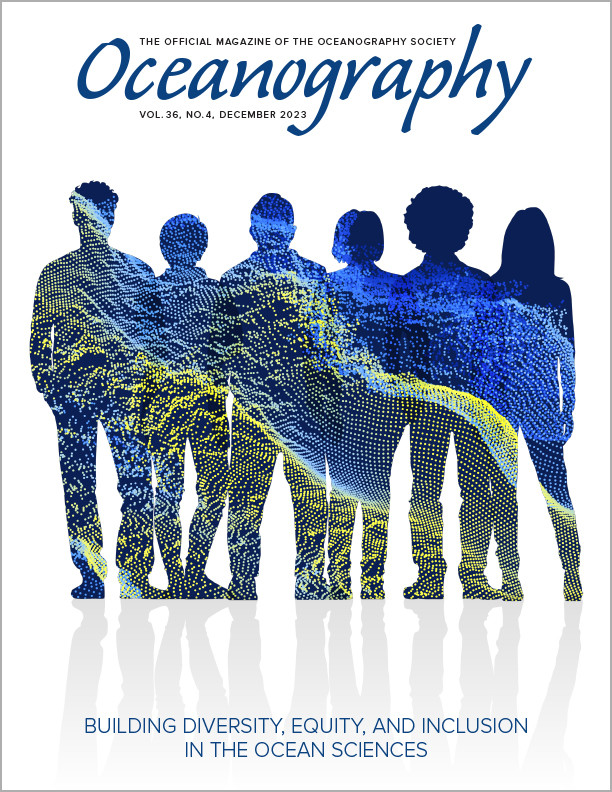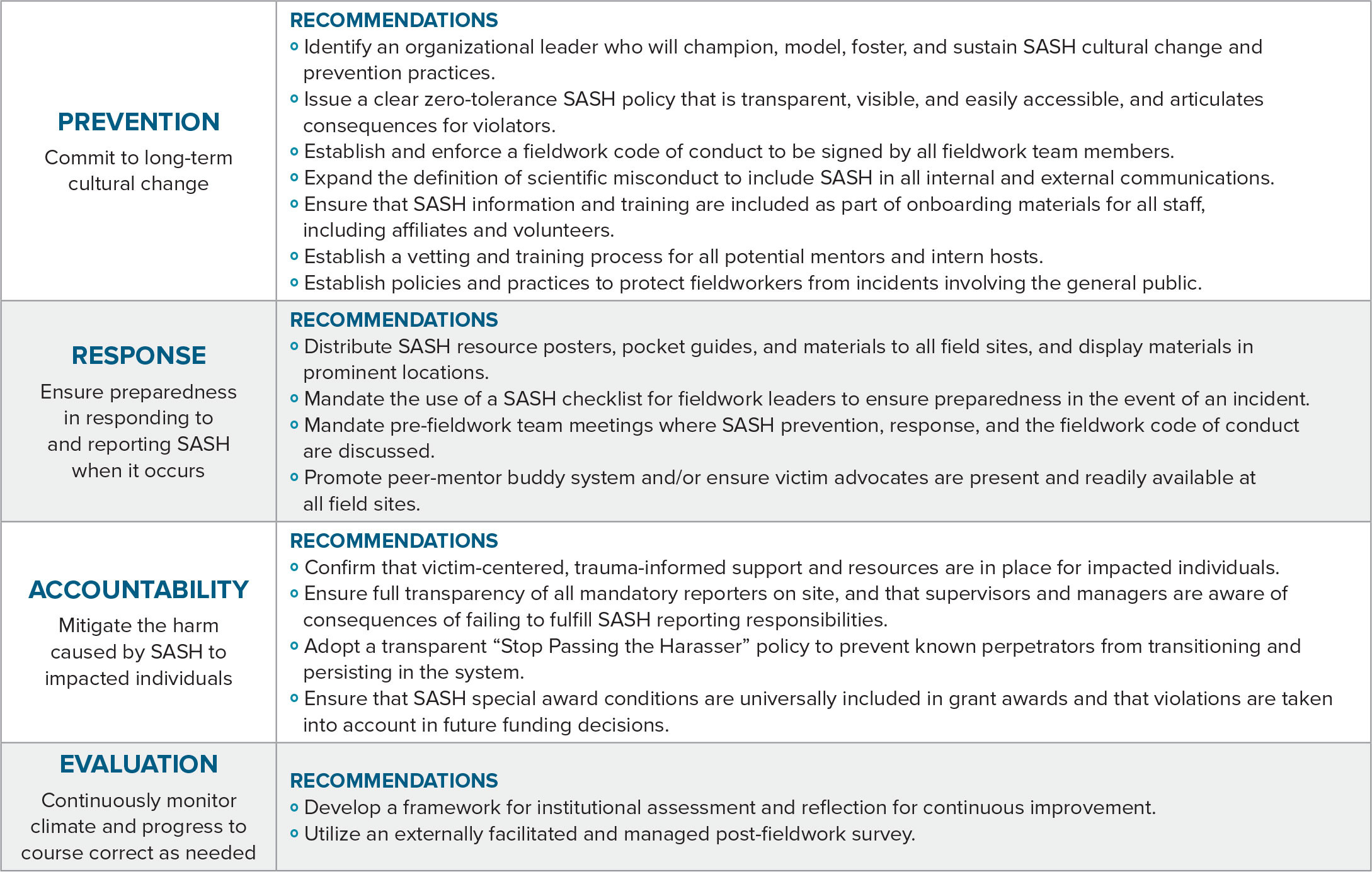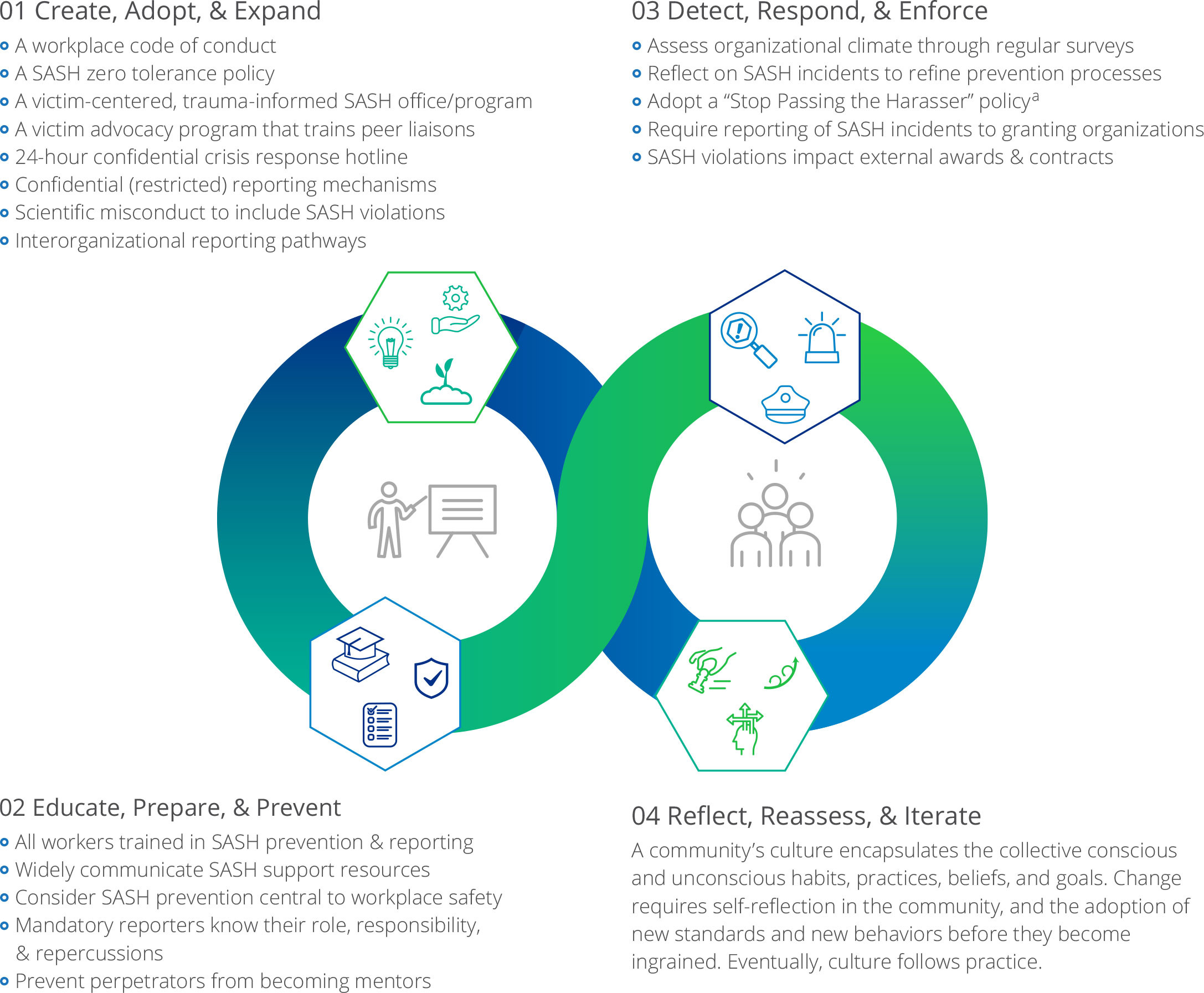Full Text
Sexual assault and sexual harassment (SASH) in STEM is a well-documented problem, particularly in academic and fieldwork settings (NASEM, 2018; Kelly and Yarincik, 2021; Ackerman et al., 2023). Historically marginalized groups in STEM (i.e., White women; Black, Indigenous, and other people of color; LGBTQ+ individuals) are particularly vulnerable to SASH due to underrepresentation and persistent, long-standing cultural norms shaped by dominant male and White identities. For individuals who hold multiple marginalized identities, the risks and impacts are compounded (Cech, 2022). SASH results in negative impacts to individual mental health and physical safety, productivity, and employee retention, and represents a barrier to entry, retention, advancement, and success of a diverse STEM workforce. Culture change within STEM, the process of shifting organizational norms in an effort to promote employee wellness, inclusion, and productivity, is needed to address this issue.
SASH prevention should be considered another form of good emergency preparedness and safety. Upon boarding a vessel or joining a research facility, researchers are oriented to what to do in the event of an emergency. Researchers do not plan to capsize, catch fire, or spill chemicals, but when something happens, they are trained in the safety procedures to follow. SASH-prevention practices belong in the same categories of discussion: clearly explained practices, attentive vigilance, and regular reassessment. Rather than managing concerns around personal safety, vulnerable researchers should be free to focus on the joys and challenges of their chosen profession and scientific inquiry. With this cultural shift, we can prevent and minimize the damage caused by SASH, and recruit, retain, and promote a more diverse, focused, inclusive, and innovative workforce.
Recognizing SASH in US Federal Government STEM Agencies
SASH in US federal government research has received relatively little attention in the peer-reviewed literature. US federal research agencies have blended workforces of federal employees, contractors, and affiliates and extend their reach into academic institutions via grant awards and cooperative agreements. As an example, the NOAA workforce numbers about 12,000 employees who work in traditional office and laboratory spaces across all 50 US states, commonwealths, and territories. NOAA often carries out its research collaboratively with multi-institutional and/or multinational groups, sometimes outside of US jurisdictions. Many NOAA researchers work in remote, isolated environments on ships or aircraft and in land-based observation stations across the globe. This complexity of the NOAA workforce and research mission can pose significant challenges to standardizing and enforcing SASH policies, training, and accountability measures.
In 2014, as a result of whistleblower allegations of SASH from individuals conducting work on behalf of NOAA, Congress ascertained that the agency lacked policies to effectively address the issue. The US public law “Actions to address sexual harassment at National Oceanic and Atmospheric Administration” passed in 2017 as Public Law 114–328 indicated risk to NOAA workers and mandated particular solutions to address the issue. In 2018, NOAA published its initial Sexual Assault and Sexual Harassment Prevention and Response Policy (NAO 202-1106; NOAA, 2018), encouraging employees to come forward when incidents occur and providing resources to support those who are impacted; an updated policy will be available later in 2023.
This article aims to advance the conversation on SASH in STEM, particularly within US federal research agencies, and describes areas of continued growth and strides NOAA has taken toward growing SASH prevention and response initiatives, which we believe can also be implemented by other STEM organizations.
Advancing SASH Prevention and Response at NOAA
In 2018, NOAA created the Workplace Violence Prevention and Response office, which works to establish a culture of professionalism and respect through violence prevention and response, and provides education, training, and victim support. NOAA, to our knowledge, is the only civilian US federal government agency that offers victim advocacy services for employees, contractors/affiliates, and anyone else who works with or conducts business on behalf of the agency (grantees, scientists, students, interns, volunteers, etc.). The office provides victim-centered, trauma-informed assistance for navigating the investigation process and an ongoing support system (regardless of whether a formal investigation is initiated) following the closure of cases. Workplace Violence Prevention and Response thus establishes an entirely new reporting pathway that extends beyond the traditional processes of the Equal Employment Opportunity Office (employee remedy for illegal discrimination) and the Office of Human Capital Services (swift action to hold the offender accountable).
A 2020 amendment (Public Law 116-259) to the original 2017 legislation makes NOAA one of the few US federal agencies to offer a non-mandatory “restricted” reporting option. This allows victims to disclose details of SASH to the Workplace Violence Prevention and Response office to receive support services without triggering an investigation. This represents a monumental broadening of options and support for SASH survivors who often choose not to report because they don’t trust the system to take appropriate action, are reporting a complaint concerning a person in power, or fear retaliation, among other reasons.
NOAA continues to grow a diverse network of more than 50 volunteer Victim Advocate Liaisons who support SASH survivors in partnership with the Workplace Violence Prevention and Response office. Victim Advocate Liaisons are peers who, as a collateral duty, have become credentialed victim advocates through the National Advocate Credentialing Program to (1) provide information and options to impacted individuals, (2) empower them to make informed decisions for next steps and safety planning, and (3) advocate on their behalf. These victim advocates extend SASH services to NOAA’s distributed offices, science centers, laboratories, and remote field stations, with a goal to have a Victim Advocate Liaison in every state and US territory where NOAA has a presence. NOAA employees and partners also have access to a 24-hour SASH helpline for live, one-on-one, confidential support via call, text, and chat, or mobile app for crisis intervention, referrals, and emotional support.
The Centers for Disease Control and Prevention released a public health approach to SASH prevention that has been endorsed by the community (CDC, 2004). Its approach divides SASH prevention into primary (preventing SASH before it happens), secondary (responding immediately to SASH to mitigate short-term consequences), and tertiary (mitigating long-term consequences) strategies. While NOAA has made strides in developing secondary and tertiary strategies by responding to and providing care and support for survivors, efforts are needed to build robust primary initiatives that prevent harm from occurring in the first place. This secondary response-focused framework is one we see in many organizations, both within and outside of the STEM sector. NOAA recognizes the need to make the far more challenging change to prevent SASH before it even occurs by developing a “primary” strategy that will transform the organizational culture regarding SASH. NOAA’s Workplace Violence Prevention and Response office has begun to build this primary SASH prevention strategy through education on individual and workplace wellness topics, informing managers and supervisors about their roles in setting expectations, and modeling healthy organizational culture.
Addressing Heightened SASH Vulnerability in Fieldwork Settings
As evidenced by the annual reports NOAA is required to submit to Congress, fieldwork locations remain the most dangerous spaces for SASH events, and targeted policies and protections are needed in these workspaces (GAO, 2021). To address this specifically, NOAA Oceanic and Atmospheric Research’s Diversity and Inclusion Advisory Committee recently conducted a multi-year, workforce-led effort that gathered experience-based data from employees (federal and affiliates) to provide recommendations to leadership on fieldwork SASH prevention and response. Findings indicated that abusive and hostile fieldwork environments still occur, that many barriers to reporting remain, and that the incorporation of employee perspectives into the creation and revision of policies and practices must be central to effective SASH prevention and safety. Based on information gathered from the listening sessions and from peer-reviewed literature, recommendations for improving policies and practices to promote SASH safety in fieldwork have been delivered to NOAA Oceanic and Atmospheric Research leaders, and early implementation of some recommendations is already underway (Table 1). These recommendations center on expanding efforts to include SASH prevention and response in all grant and other external funding pathways; creating and strengthening policies and practices to normalize SASH prevention and response through education and preparation of all fieldworkers; expansion and enforcement of detection, protection, and response methods; and applying continuous learning and ongoing policy improvement methods throughout the agency’s endeavors. Many of the recommendations include education and training efforts to model and normalize inclusive, respectful behavior, to disrupt harmful social norms, and to shift mindsets in order to effect culture change over time. Many of these ideas can be applied to STEM organizations to develop or advance their SASH prevention and response frameworks, particularly within fieldwork settings.
TABLE 1. Summary of SASH prevention and response in fieldwork recommendations that were provided to NOAA leadership by the NOAA Oceanic and Atmospheric Research’s Diversity and Inclusion Advisory Committee working group. The full document referenced sources and included examples of policies, practices, and/or wording used by other agencies and institutions. > High res table |
Further Elevating SASH in STEM Workspaces to Cultivate Cultural Change
SASH thrives in the dark. A culture of shame is deeply ingrained in these forms of abuse. The work of NOAA and other STEM agencies and organizations to advance the SASH conversation is a step toward illuminating the circumstances where these kinds of abuses are prevalent and breaking the cycle of SASH. Shedding a light on SASH includes creation, adoption, and expansion of victim-centered policies and services; education, preparation, and prevention to acknowledge SASH as a workplace harm and normalize good over bad behavior; detection, response, and enforcement to swiftly identify abusers and enforce zero-tolerance; and reflection, reassessment, and iteration to dismantle long-standing, unhealthy norms and transform organizational culture (Figure 1).
To cultivate a workplace where speaking up doesn’t cause additional harm, organizations must adopt policies to ensure that all impacted individuals are protected and supported when they come forward (Figure 1, 01 Create, Adopt, & Expand). Preventing SASH before it occurs involves commitment to educating the entire workforce on SASH policies, the standard of behavior, and available support resources in order to prepare the workforce to report bad behavior when it occurs and make policies and repercussions more transparent (Figure 1, 02 Educate, Prepare, & Prevent). By establishing a mechanism, such as a database, that can be used to track SASH perpetrators who may be within an organization or externally supported through grant awards, bad actors will no longer be able to slip through the cracks and be emboldened to continue their bad behavior (Figure 1, 03 Detect, Respond, & Enforce). Reflecting on SASH cases and the environmental harms that give rise to hostile work environments will be key to eliminating high-risk situations for SASH and informing a comprehensive approach to prevention (Figure 1, 03 Detect, Respond, & Enforce).
Cultural change happens over time as members of a community decide to adopt new social norms and rules, thereby applying ground-up social pressure regarding what behavior is acceptable (Figure 1, 04 Reflect, Reassess, & Iterate). This movement can be sparked by leaders choosing to buy into cultural change by modeling behavior and transparently and swiftly enforcing accountability measures that build credibility for an organization’s commitment to eliminating SASH. The STEM culture around SASH can in some cases be deeply ingrained, and adopting new social norms and habits may be cumbersome at first. It will require the habits, expectations, and behaviors of many individuals to change and for individuals to feel empowered to speak up to disrupt long-standing social and cultural norms. Without unwavering commitment of leadership to culture change and engagement from the broader workforce, response to SASH incidents, rather than their prevention, will prevail. Messaging organizational culture-change goals will gain momentum when embraced, modeled, and enacted by leaders at all levels. Culture change percolates through the organization when individuals are empowered to use their voices without fear of retribution if something doesn’t seem right and can safely seek support when a particular situation is beyond their influence.
|
|
Policies are only effective if enforced, and enforcement hinges on the actions of all involved. Strict adherence is necessary for them to be effective, and transparent and swift repercussions are needed when violations occur. Whole-organization engagement, encompassing individual and leadership support across the team-to-organization spectrum, is needed to normalize the conversation around SASH and create safe spaces that promote and improve employee wellness and productivity. This includes engaging non-marginalized individuals in the conversation of allyship; holding peers accountable for words, actions, and inactions; and utilizing available tools and processes to channel change.
Ultimately, robust SASH policies will set the stage for an inclusive culture where everyone is ensured a safe, productive working environment. Organizations such as the National Academies of Sciences, Engineering, and Medicine’s Action Collaborative on Preventing Sexual Harassment in Higher Education (of which NOAA is a member) regularly report on evolving practices and policies regarding SASH within STEM organizations. Member organizations are pushing to move beyond basic legal compliance to implement evidence-based policies and practices to address and prevent SASH and promote a climate of inclusivity, civility, and respect across their organizations. Through organizations such as the Action Collaborative, the STEM community has the opportunity to come together to exchange ideas and embrace cultural change that will help our field to acknowledge and then shed historical norms, abuses, and inequities.
Let us imagine a workplace that is free from all forms of abuse and harassment, where each one of us is free to bring our full, brilliant, creative selves to work, and to excel equitably with everyone else—a place where our intellectual and emotional bandwidth is spent not on daily survival and mitigating harm but rather on innovating for our teams, institutions, and organizations. It is very clear that we must focus simultaneously on individual accountability and institutional processes, policies, procedures, and practices. Structural and procedural changes are foundational components of cultural change, but shifting value systems, and changing individual and group norms, behaviors, and beliefs, are much more challenging and require an all-hands-on-deck approach at every level of an organization and throughout all levels of the workforce. Change is possible, but it requires each one of us to make very different choices as we reimagine a way forward together.
The views and opinions expressed herein are those of the authors and do not necessarily reflect the views and opinions of the NOAA and/or the Department of Commerce.



